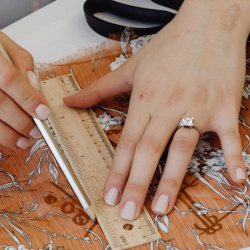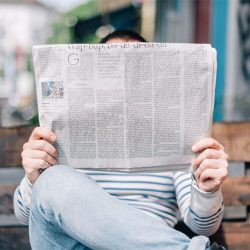Fashion is constantly evolving, with trends changing faster than ever. From colors and fabrics to styles and silhouettes, predicting what consumers will want next season is a critical part of the industry. This is where fashion forecasting comes into play, shaping how designers, retailers, and brands prepare collections.
In this blog, you’ll learn what is fashion forecasting, why it’s important in the fashion industry, the different types and processes involved, and how to become a forecaster. We’ll also cover career opportunities, challenges, and future trends to help you understand why this role is becoming one of the most exciting paths in fashion.
- What is Fashion Forecasting?
- Why Is Fashion Forecasting Important in the Industry?
- Types of Fashion Forecasting
- The Process of Fashion Forecasting
- Careers in Fashion Forecasting
- Challenges & Limitations of Fashion Forecasting
- Future of Fashion Forecasting in a Digital World
- Conclusion: Why Fashion Forecasting Shapes the Industry
- FAQs
What Is Fashion Forecasting?
Fashion forecasting is the practice of predicting future fashion trends based on consumer behaviour, cultural influences, market data, and social shifts. It helps brands and designers anticipate what colors, fabrics, and styles will dominate upcoming seasons. Forecasting involves a combination of research, observation, and analytics. It’s not just about guessing what people will wear — it’s about using data, psychology, and creativity to predict what will sell in global markets.Why Is Fashion Forecasting Important in the Industry?
Fashion is one of the most competitive industries, and staying ahead of trends is essential. Let’s look at why forecasting plays a vital role:Understanding Consumer Behavior
- Forecasting helps brands analyze buying habits, preferences, and lifestyle choices of consumers.
- By studying psychology and demographics, fashion companies can design collections that meet customer expectations.
- Example: The rise of sustainable fabrics is a direct result of consumer demand for eco-friendly clothing.
Predicting Seasonal & Market Trends
- Fashion forecasting ensures brands know what colors, prints, and silhouettes will be popular in specific seasons.
- This allows retailers to stock their inventory with items that match consumer demand.
- For instance, pastel shades for spring or oversized coats for winter can be predicted well in advance.
Helping Brands Stay Competitive
- With accurate forecasting, brands can launch products at the right time and maintain an edge in the market.
- It reduces the risk of unsold inventory and boosts profitability.
- In a fast-moving fashion landscape, forecasting ensures companies remain relevant and competitive.
Types of Fashion Forecasting
Fashion forecasting can be divided into multiple categories based on timelines and approaches.Short-Term Forecasting (Seasonal Trends)
- Short-term forecasting focuses on predicting fashion trends that will emerge within the next 6 to 12 months, making it crucial for seasonal collections like Spring/Summer or Fall/Winter.
- This type of fashion forecasting relies on analyzing runway shows, street styles, and emerging looks from influencers to anticipate what will be in demand.
- Retail sales data, consumer preferences, and fast-changing market dynamics are studied to help brands quickly adapt and design collections that stay relevant.
- By using seasonal fashion forecasting, companies can reduce risks, align production with demand, and deliver styles that match current consumer expectations.
Long-Term Forecasting (Macro Trends)
- Long-term forecasting looks 2–5 years ahead, focusing on broader cultural, technological, and societal shifts that influence fashion trends. It allows brands to anticipate changes in consumer values and lifestyle choices.
- For example, the rise of gender-neutral fashion and the increasing demand for eco-conscious design are trends identified through long-term fashion forecasting. These trends reflect lasting shifts in consumer behavior and societal priorities.
- This type of fashion forecasting helps brands align their strategies with long-term market demands, ensuring that collections, materials, and marketing campaigns resonate with evolving values and global trends.
- By planning for macro trends, fashion companies can make sustainable business decisions, invest in innovative fabrics, and build collections that remain relevant over multiple seasons.
Qualitative vs Quantitative Forecasting
- Qualitative forecasting is based on creative analysis, observations, and cultural trends. It involves studying runway shows, influencer styles, street fashion, and lifestyle shift to predict what might become popular. This approach allows fashion forecasting to capture the emotional and cultural aspects of trends.
- Quantitative forecasting relies on data such as sales reports, consumer surveys, market analytics, and AI-driven insights. By analyzing numbers and patterns, brands can make evidence-based predictions, reduce risks and aligning production with consumer demand.
- Combining qualitative and quantitative approaches provides a balanced strategy in fashion forecasting, blending creativity with data-driven insights. This ensures brands can anticipate trends accurately while remaining culturally relevant and commercially viable.
The Process of Fashion Forecasting
Fashion forecasting is a multi-step process that combines creativity, cultural understanding, and analytical methods to predict upcoming trends. It helps designers, brands, and retailers make informed decisions about what to produce, market, and sell. By blending art and science, fashion forecasting ensures collections resonate with consumer demand and market expectations.Research & Data Collection
- The first step in fashion forecasting is gathering extensive data from multiple sources. This includes runway shows, street style observations, influencer trends, and retail sales reports.
- Brands also monitor global events, economic shifts, and pop culture developments, as these factors heavily influence consumer choices.
- Effective data collection helps brands anticipate emerging patterns, reduce risks of unsold inventory, and stay competitive in the fast-paced fashion industry.
Analyzing Cultural & Social Influences
- Cultural and social factors are crucial in fashion forecasting, as trends often reflect societal moods and lifestyle changes.
- Social movements, lifestyle evolution, and political developments shape what people choose to wear. For example, the pandemic significantly increased the demand for loungewear and athleisure, reflecting comfort-focused consumer priorities.
- Understanding these influences helps brands create designs that resonate emotionally with their target audience.
Studying Color, Fabric & Silhouette Trends
- Fashion forecasting agencies like WGSN analyze upcoming color palettes, textures, and silhouettes to identify what will trend in the coming seasons.
- Designers use these insights to build collections that align with predicted consumer preferences, ensuring relevance and appeal.
- From vibrant prints to minimalistic shapes, this step allows brands to combine aesthetic vision with market demand.
Using Technology & AI in Forecasting
- Technology is transforming fashion forecasting, making trend predictions more precise and data driven. AI-powered tools can analyze real-time consumer behavior, online shopping patterns, and social media interactions.
- Machine learning algorithms track Instagram posts, TikTok trends, search queries, and e-commerce data to identify emerging preferences quickly.
- Integrating AI ensures forecasting is not only creative but also responsive, helping brands adjust designs and marketing strategies efficiently.
Careers in Fashion Forecasting
Fashion forecasting offers a dynamic and creative career path. Here’s what you need to know:How to Become a Fashion Forecaster
- Start by building a foundation in fashion design, textiles, or merchandising.
- Enroll in specialized programs such as a Fashion Style Course Online or a Fashion Design Diploma to gain skills.
- Gain experience through internships with forecasting agencies, fashion houses, or retail companies.
Skills Required for a Fashion Forecaster
- Trend analysis & observation skills to identify shifts in culture and style.
- Research & analytical skills to study data and consumer behavior.
- Creativity & visualization to predict and present upcoming trends effectively.
- Strong communication skills to work with designers, marketers, and retailers.
Career Opportunities in Brands, Agencies & Retail
- Trend Forecaster in global agencies like WGSN or Trendalytics.
- Fashion Buyer for luxury brands or retail chains, selecting collections based on forecasts.
- Market Analyst in retail companies studying consumer data.
- Creative Consultant helping brands align with future design trends.
Challenges & Limitations of Fashion Forecasting
- Rapidly changing consumer preferences can make predictions difficult.
- Global crises, like pandemics or recessions, can disrupt long-term trends.
- Forecasting requires balancing creativity with hard data, which is not always accurate.
- Dependence on technology can sometimes overlook cultural nuances.
Future of Fashion Forecasting in a Digital World
- The future of fashion forecasting is being reshaped by digital innovation, technology, and changing consumer expectations. AI, big data, and machine learning will allow forecasters to predict trends in real time with greater accuracy. This means brands can respond faster to shifting demands and reduce the risk of producing styles that don’t sell.
- Digital fashion, AR clothing try-ons, and virtual platforms such as the metaverse are creating new opportunities for trend observation and consumer engagement. Forecasters will need to adapt their methods to include these immersive experiences to better understand how people interact with fashion in a digital space.
- Sustainability is also becoming a major focus in fashion forecasting, as eco-conscious consumers drive demand for sustainable fabrics, ethical production, and circular fashion practices. Forecasters will play a key role in predicting eco-friendly trends and helping brands stay ahead in a competitive market.
- In the coming years, fashion forecasting will blend creativity, technology, and consumer-led innovation more than ever. Professionals who embrace AI tools, digital insights, and sustainability-focused strategies will lead the way in shaping the fashion industry.
Conclusion: Why Fashion Forecasting Shapes the Industry
Fashion forecasting is the backbone of the global fashion system. It helps brands minimize risks, maximize profits, and deliver collections that resonate with consumers. By combining creativity, cultural analysis, and technology, forecasting professionals play a pivotal role in shaping what people wear. For aspiring professionals, gaining the right skills through structured learning and real-world experience opens doors to exciting roles in fashion brands, agencies, and retail. As the industry evolves, fashion forecasters will remain at the heart of innovation and style prediction.FAQs
What is fashion forecasting and how does it work?
Fashion forecasting is the practice of predicting future fashion trends by analyzing consumer behavior, cultural influences, and market data. It works by combining creative observation with technology and analytics.Why is fashion forecasting important for fashion brands?
It helps brands design collections that align with upcoming trends, reduce unsold stock, and stay competitive in the global market.How to become a fashion forecaster step by step?
Pursue education in fashion or design, gain experience with forecasting agencies, and stay updated on global cultural and fashion movements.What skills do you need for a career in fashion forecasting?
You need strong analytical skills, creativity, cultural awareness, trend-spotting ability, and communication skills.What are the types of fashion forecasting?
The main types are short-term forecasting, long-term forecasting, and qualitative vs quantitative forecasting.How is technology changing the future of fashion forecasting?
AI, big data, and machine learning are making trend predictions more accurate by tracking consumer habits, online shopping, and social media activity in real-time.Is fashion forecasting a good career choice?
Yes, it offers creative freedom, global exposure, and lucrative opportunities in agencies, retail, and luxury brands.What challenges do fashion forecasters face today?
Challenges include fast-changing consumer demands, unpredictable global events, and balancing creativity with data-driven accuracy.(Visited 40 times, 1 visits today)
Popular Search
Top 10 DJ India
Makeup Steps
Advantages of Makeup
Interior Designer Salary
Makeup Artist Course
Benefits Of Photography
Hospital Waste Management
Types of Fashion Designing
Types of Lenses in Photography
How to Become a Radio Jockey
Best Nutrition Courses in India
Importance of Media Management
How To Become a Dietitian in India
Importance of Nutrition in Health
Interior Design History and Origins
Top 10 Famous Interior Designers
Top 10 Music Labels in India
Top 10 Best Animation Studios in India
Top 10 Nutraceutical Companies in India
Top 10 Fashion Designers in the World
How To Write a TV Commercial Script
Top 10 Career Opportunities in Fashion Designing
Advantages and Disadvantages of Animation



















